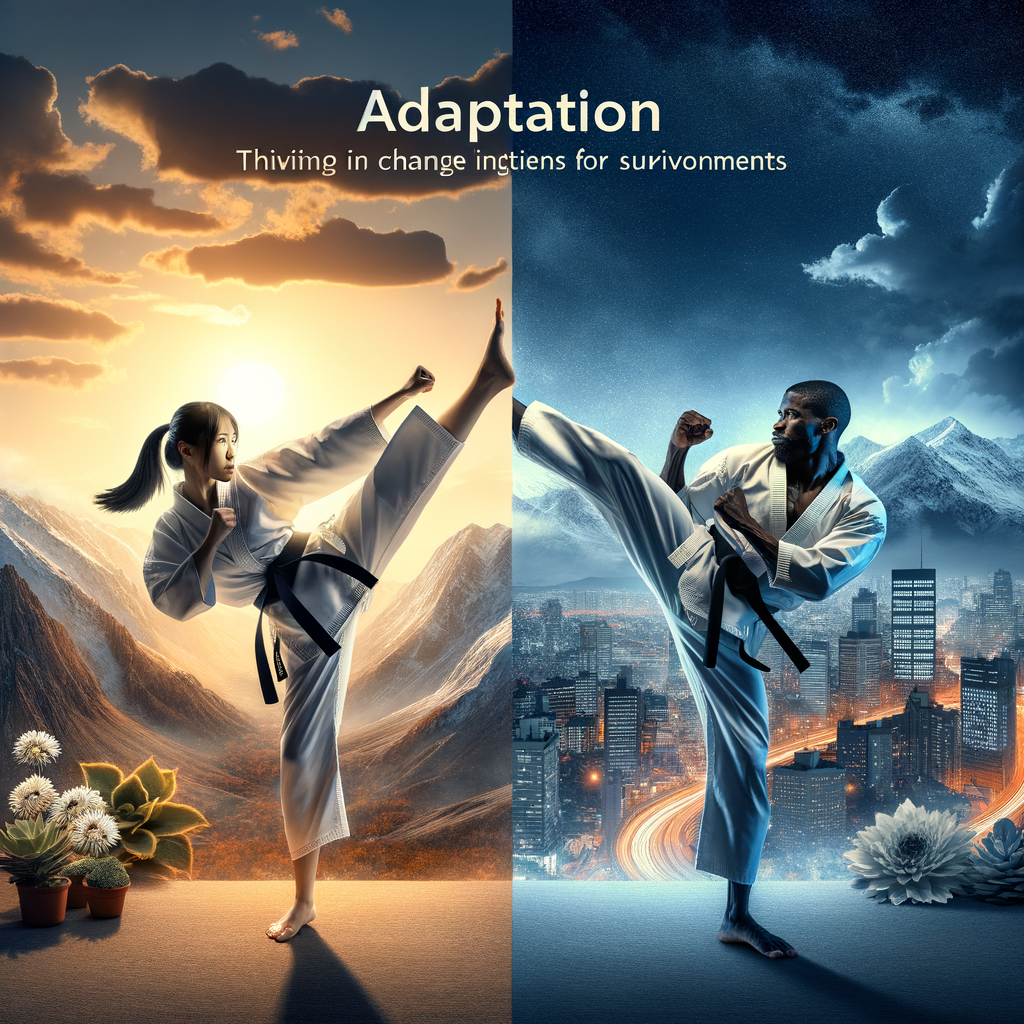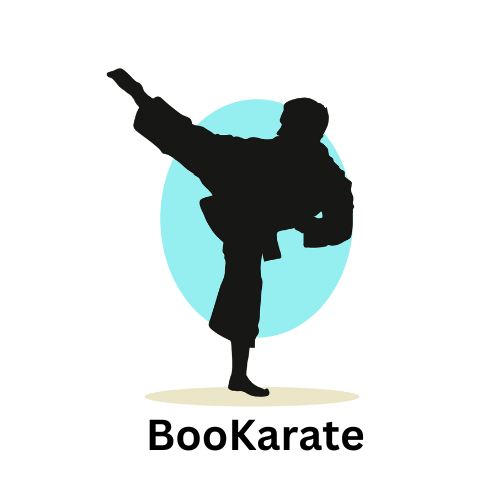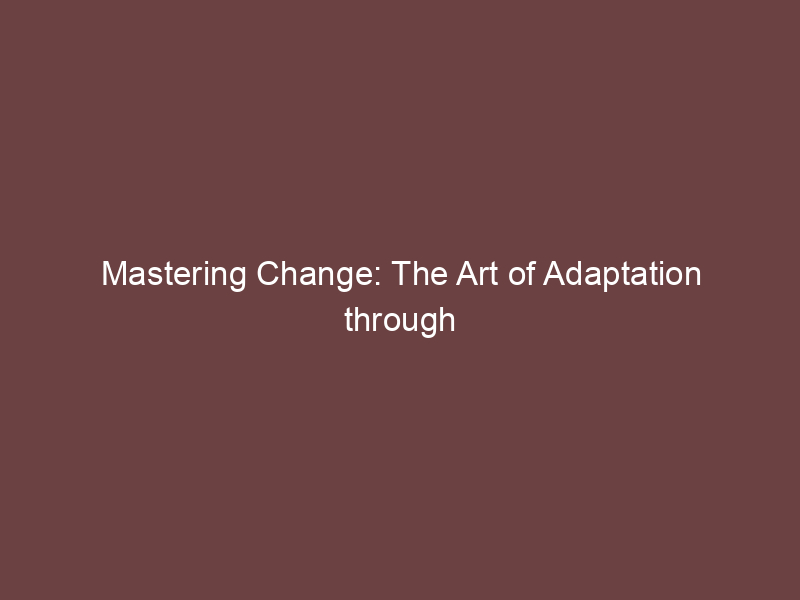
Introduction to Karate and Adaptation
Welcome to our comprehensive guide on Karate and the importance of adaptation in martial arts. In this section, we will delve into the concept of Karate, the significance of adaptation in martial arts, and how to thrive in changing environments. Let’s get started!
-
- Understanding the concept of Karate
Karate, a Japanese martial art, is more than just a method of self-defense. It is a discipline that requires physical and mental strength, focus, and determination. Originating from the Ryukyu Kingdom, now known as Okinawa, Japan, Karate emphasizes the use of striking techniques, such as punching, kicking, knee strikes, and elbow strikes. However, it’s not just about the physical moves. Karate also promotes values like respect, humility, and patience. It’s a holistic approach to personal development and self-improvement.
-
- Importance of Adaptation in martial arts
Adaptation is a crucial aspect of martial arts. It refers to the ability to adjust and modify techniques based on the situation at hand. In Karate, no two opponents or circumstances are the same. Therefore, a good Karateka (a practitioner of Karate) must be able to adapt their strategies and techniques to overcome their opponent. Adaptation in martial arts is not just physical, but also mental. It involves quick thinking, decision-making, and problem-solving skills.
-
- Thriving in changing environments: A brief overview
Adaptation is not only important in the dojo (training hall) but also in life. Just like in Karate, life often presents us with unexpected challenges. The ability to adapt and thrive in changing environments is a valuable skill that can be honed through martial arts training. Whether it’s a new school, a new job, or a new city, the principles of adaptation learned in Karate can help us navigate these changes with grace and resilience.
In the following sections, we will further explore the connection between Karate and resilience, the key to survival in martial arts, and how Karate can be adapted to different environments. Stay tuned!
The Connection between Karate and Resilience
When we think of Karate, we often picture high kicks, swift punches, and intense focus. But there’s a deeper layer to this martial art that’s often overlooked: its ability to foster resilience. Let’s delve into this connection.
-
- How Karate Training Builds Resilience
Resilience is the ability to bounce back from adversity, and Karate training is a powerful tool for building this trait. Karate teaches discipline, patience, and perseverance. When practicing Karate, you’re constantly faced with challenges and obstacles. Whether it’s mastering a new technique or facing a stronger opponent, you learn to stay calm under pressure and to keep trying until you succeed. This “never give up” attitude is the essence of resilience.
-
- Case Study: Resilience through Karate
Consider the story of a young girl named Lily. She was shy and often struggled with self-confidence. Her parents enrolled her in a Karate class, hoping it would help her come out of her shell. At first, Lily found the training tough and was often tempted to quit. But with encouragement from her sensei (teacher), she stuck with it. Over time, she not only learned to perform complex Karate moves, but also developed a new-found resilience. She became more confident, more assertive, and better equipped to handle life’s challenges. Lily’s story is a testament to the transformative power of Karate.
-
- Key Takeaways: Karate and Resilience
So, what can we learn from this? First, Karate is more than just a physical activity. It’s a discipline that fosters mental strength and resilience. Second, resilience is not something you’re born with; it’s a skill that can be developed. And Karate is one of the many ways to do so. Finally, the benefits of Karate extend beyond the dojo (training hall). The resilience you build through Karate can help you navigate the ups and downs of life with grace and grit.
Whether you’re a child like Lily or an adult looking to develop mental toughness, Karate can offer you valuable lessons in resilience. So, why not give it a try?
Martial Arts Adaptation: The Key to Survival
In the world of martial arts, adaptation is not just a strategy; it’s a necessity for survival. This is particularly true in the realm of Karate, where styles can vary greatly and the environment can dictate the most effective approach. Let’s delve into how we can adapt Karate styles in a practical manner.
Adapting Karate Styles: A Practical Approach
Adapting Karate styles is not about discarding traditional techniques but rather about understanding and applying them in different contexts. Here’s how you can do it:
-
- Understanding different Karate styles
There are many styles of Karate, each with its unique techniques and philosophies. For instance, Shotokan Karate focuses on long, deep stances and powerful strikes, while Shito-Ryu Karate is known for its speed and combination techniques. Understanding these differences is the first step towards effective adaptation.
-
- How to adapt Karate styles based on the environment
Once you understand the different Karate styles, you can begin to adapt them based on your environment. For example, in a confined space, you might find that the quick, close-range techniques of Shito-Ryu Karate are more effective than the long stances of Shotokan Karate. It’s all about using the right tool for the job.
-
- Example: Adapting Karate styles for survival
Imagine you’re in a situation where you need to defend yourself. You’re in a narrow alley and your attacker is close. In this scenario, the long, deep stances of Shotokan Karate might not be practical. Instead, you could adapt your style to use the quick, close-range techniques of Shito-Ryu Karate. This is a prime example of how adapting Karate styles can be key to survival.
The goal of Karate is not to rigidly adhere to a single style but to adapt and evolve in response to the situation at hand. By understanding and adapting different Karate styles, you can ensure your survival and success in any environment.
Change in Martial Arts: Embracing the Inevitable
Change is a constant in life, and martial arts are no exception. The ability to adapt and embrace change is crucial for any martial artist. Let’s explore why change is inevitable in martial arts, how to embrace it, and a case study of thriving through change.
-
- Why change is inevitable in martial arts
Martial arts, like any other discipline, evolve over time. New techniques are developed, old ones are refined, and strategies shift based on new knowledge and understanding. Moreover, as a martial artist grows and matures, their style and approach to the art will also change. This is a natural and necessary part of growth and development in martial arts.
-
- How to embrace change in martial arts
Embracing change in martial arts involves being open to new ideas, techniques, and strategies. It requires a willingness to learn and grow, even when it means stepping out of your comfort zone. Regular practice, continuous learning, and a positive mindset are key to embracing change in martial arts. Remember, change is not a threat but an opportunity for growth and improvement.
-
- Case study: Thriving through change in martial arts
Consider the story of a martial artist named Tom. Tom started practicing karate at a young age. Over the years, he developed a strong and effective style. However, as he grew older, he began to struggle with flexibility and speed. Instead of giving up or sticking stubbornly to his old techniques, Tom embraced the change. He adapted his style, focusing more on precision and strategy rather than speed and agility. This change allowed him to continue practicing and enjoying karate, even as his physical abilities changed. Tom’s story is a great example of how embracing change can lead to continued success in martial arts.
Change in martial arts is not only inevitable but also beneficial. Embracing change allows martial artists to grow, adapt, and thrive in their practice. So, don’t fear change – embrace it!
Karate in Different Environments: A Comprehensive Guide
As a martial art, Karate is not only about physical strength but also about adaptability and resilience. It’s about learning to adjust your techniques to different environments. In this section, we will delve into how Karate adapts to various environments, provide examples, and summarize key takeaways.
-
- Adapting Karate Techniques for Different Environments
Adapting Karate techniques to different environments is a critical skill for any practitioner. Whether you’re training in a dojo, practicing in a park, or defending yourself on a busy street, the environment can significantly impact your strategy and technique. For instance, a spinning kick might work well in a spacious dojo but could be less effective in a crowded place. Therefore, it’s essential to learn how to modify your techniques according to the environment.
-
- Examples of Karate in Different Environments
Let’s consider some examples to understand this better. In a dojo, the floor is usually flat and stable, making it easier to execute complex moves. However, if you’re practicing on a beach, the uneven and shifting sand can make it challenging to maintain balance. In such a case, you might need to adjust your stance and focus more on stability. Similarly, if you’re in a crowded place, you might need to rely more on close-range techniques like punches and elbow strikes, rather than high kicks.
-
- Key Takeaways: Karate in Different Environments
From the above discussion, the key takeaways are that adaptability is a crucial aspect of Karate. It’s not just about learning a set of moves, but about understanding when and how to use them effectively. Different environments require different strategies and techniques. By learning to adapt, you can become a more versatile and effective Karate practitioner.
| Environment | Adaptation |
|---|---|
| Dojo | Ability to use a wide range of techniques |
| Beach | Adjust stance for stability on uneven ground |
| Crowded Place | Focus on close-range techniques |
In conclusion, Karate is a martial art that requires not only physical strength but also mental agility and adaptability. By learning to adapt your techniques to different environments, you can become a more effective and versatile Karate practitioner.
Conclusion: Mastering Change through Karate
As we reach the end of our journey exploring the connection between Karate and adaptation, let’s take a moment to reflect on what we’ve learned and how we can apply these lessons in our daily lives.
-
Recap: The Art of Adaptation through Karate
Karate, a martial art form with deep roots in history, teaches us more than just self-defense. It imparts the invaluable lesson of adaptation. Whether it’s adjusting to different environments or dealing with unexpected situations, Karate trains us to be flexible and resilient. We learned about the concept of ‘Mizu No Kokoro’, or ‘Mind like Water’, which encourages us to adapt to changes just as water molds itself according to its container.
-
Key Takeaways: Mastering Change in Karate
Mastering change in Karate is about developing a mindset that embraces change rather than resisting it. It’s about understanding that change is a constant part of life and that our ability to adapt determines our success. We delved into how this philosophy is reflected in Karate’s various techniques and forms, and how it can be applied in our personal and professional lives.
Key Takeaway Explanation Adaptability Being flexible and ready to adjust to any situation. Resilience Staying strong and bouncing back from adversity. Embracing Change Accepting change as a part of life and using it to grow. -
Final Thoughts: Karate for Survival
Karate is more than just a martial art; it’s a way of life. It teaches us to survive and thrive in a changing world. The lessons of adaptability, resilience, and embracing change that Karate imparts are not just for the dojo but for every aspect of our lives. As the famous Karate master, Gichin Funakoshi, once said, “The ultimate aim of Karate lies not in victory or defeat, but in the perfection of the character of its participants“. Let’s carry these lessons with us as we navigate the ever-changing landscapes of our lives.






